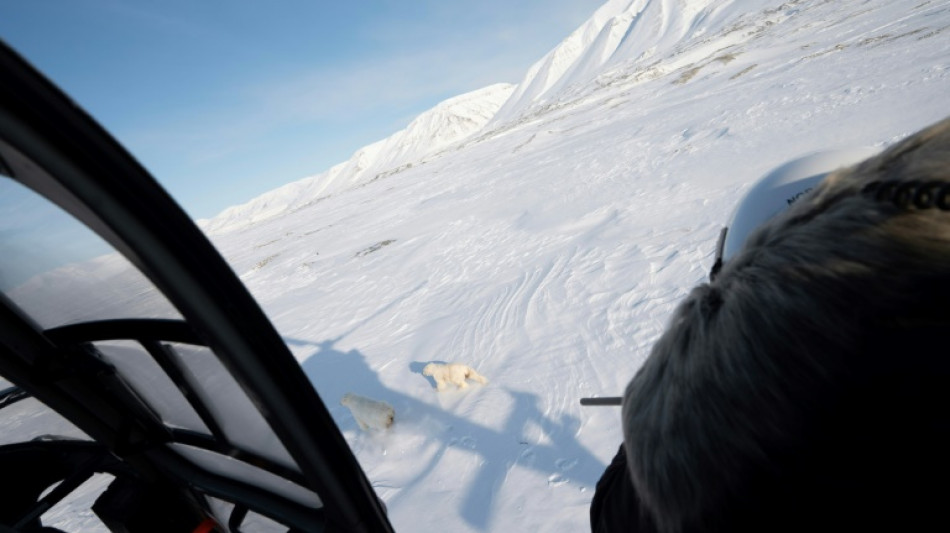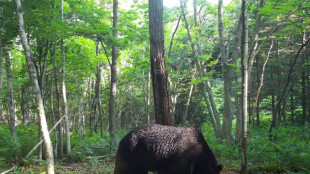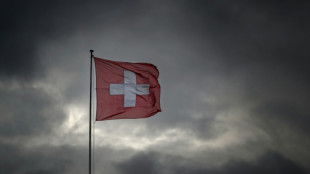
-
 Kyrgios targets 'miracle' Australian Open return after knee improves
Kyrgios targets 'miracle' Australian Open return after knee improves
-
'AI president': Trump deepfakes glorify himself, trash rivals

-
 Belgium probes drone sightings after flights halted overnight
Belgium probes drone sightings after flights halted overnight
-
Five things to know about 'forest COP' host city Belem

-
 World leaders to rally climate fight ahead of Amazon summit
World leaders to rally climate fight ahead of Amazon summit
-
Engine fell off US cargo plane before deadly crash: officials

-
 Mexican leader calls for tougher sexual harassment laws after attack
Mexican leader calls for tougher sexual harassment laws after attack
-
Meghan Markle set for big screen return: reports

-
 Japan deploys troops after wave of deadly bear attacks
Japan deploys troops after wave of deadly bear attacks
-
FIFA announce new peace prize to be awarded at World Cup draw in Washington

-
 Australia's Cummins hints at return for second Ashes Test
Australia's Cummins hints at return for second Ashes Test
-
Boeing settles with one plaintiff in 737 MAX crash trial

-
 Man City win as Inter stay perfect, Barca held in Champions League
Man City win as Inter stay perfect, Barca held in Champions League
-
French superstar DJ Snake wants new album to 'build bridges'

-
 Barca rescue draw at Club Brugge in six-goal thriller
Barca rescue draw at Club Brugge in six-goal thriller
-
Foden hits top form as Man City thrash Dortmund

-
 NBA officials brief Congress committee over gambling probe
NBA officials brief Congress committee over gambling probe
-
Inter beat Kairat Almaty to maintain Champions League perfection

-
 Newcastle sink Bilbao to extend Champions League winning run
Newcastle sink Bilbao to extend Champions League winning run
-
Wall Street stocks rebound after positive jobs data

-
 LPGA, European tour partner with Saudis for new Vegas event
LPGA, European tour partner with Saudis for new Vegas event
-
Eyes turn to space to feed power-hungry data centers

-
 Jazz lose Kessler for season with shoulder injury
Jazz lose Kessler for season with shoulder injury
-
League scoring leader Messi among MLS Best XI squad

-
 MLS bans Suarez for Miami's winner-take-all playoff match
MLS bans Suarez for Miami's winner-take-all playoff match
-
McIlroy appreciates PGA of America apology for Ryder Cup abuse

-
 Garnacho equaliser saves Chelsea in Qarabag draw
Garnacho equaliser saves Chelsea in Qarabag draw
-
Promotions lift McDonald's sales in tricky consumer market

-
 Five things to know about New York's new mayor
Five things to know about New York's new mayor
-
Anisimova beats Swiatek to reach WTA Finals last four

-
 US Supreme Court appears skeptical of Trump tariff legality
US Supreme Court appears skeptical of Trump tariff legality
-
AC Milan post third straight annual profit on day of San Siro purchase

-
 Angelina Jolie visits Ukrainian frontline city, media reports say
Angelina Jolie visits Ukrainian frontline city, media reports say
-
UN says forests should form key plank of COP30

-
 Star designer Rousteing quits fashion group Balmain
Star designer Rousteing quits fashion group Balmain
-
Mexico's Sheinbaum steps up cartel fight after murder of anti-narco mayor

-
 Attack on funeral in Sudan's Kordofan region kills 40: UN
Attack on funeral in Sudan's Kordofan region kills 40: UN
-
Key PSG trio set for spell on sidelines

-
 Democrats punch back in US elections - and see hope for 2026
Democrats punch back in US elections - and see hope for 2026
-
BMW reports rising profitability, shares jump

-
 US Supreme Court debates legality of Trump's tariffs
US Supreme Court debates legality of Trump's tariffs
-
Bolivia Supreme Court orders release of jailed ex-president Jeanine Anez

-
 Wall Street stocks rise after positive jobs data
Wall Street stocks rise after positive jobs data
-
'Hostage diplomacy': longstanding Iran tactic presenting dilemma for West

-
 Rybakina stays perfect at WTA Finals with win over alternate Alexandrova
Rybakina stays perfect at WTA Finals with win over alternate Alexandrova
-
Le Garrec welcomes Dupont help in training for Springboks showdown

-
 Brussels wants high-speed rail linking EU capitals by 2040
Brussels wants high-speed rail linking EU capitals by 2040
-
Swiss business chiefs met Trump on tariffs: Bern

-
 At least 9 dead after cargo plane crashes near Louisville airport
At least 9 dead after cargo plane crashes near Louisville airport
-
France moves to suspend Shein website as first store opens in Paris


The eye-opening science of close encounters with polar bears
It's a pretty risky business trying to take a blood sample from a polar bear -- one of the most dangerous predators on the planet -- on an Arctic ice floe.
First you have to find it and then shoot it with a sedative dart from a helicopter before a vet dares approach on foot to put a GPS collar around its neck.
Then the blood has to be taken and a delicate incision made into a layer of fat before it wakes.
All this with a wind chill of up to minus 30C.
For the last four decades experts from the Norwegian Polar Institute (NPI) have been keeping tabs on the health and movement of polar bears in the Svalbard archipelago, halfway between Norway and the North Pole.
Like the rest of the Arctic, global warming has been happening there three to four times faster than elsewhere.
But this year the eight scientists working from the Norwegian icebreaker Kronprins Haakon are experimenting with new methods to monitor the world's largest land carnivore, including for the first time tracking the PFAS "forever chemicals" from the other ends of the Earth that finish up in their bodies.
An AFP photographer joined them on this year's eye-opening expedition.
- Delicate surgery on the ice -
With one foot on the helicopter's landing skid, vet Rolf Arne Olberg put his rifle to his shoulder as a polar bear ran as the aircraft approached.
Hit by the dart, the animal slumped gently on its side into a snowdrift, with Olberg checking with his binoculars to make sure he had hit a muscle. If not, the bear could wake prematurely.
"We fly in quickly," Oldberg said, and "try to minimise the time we come in close to the bear... so we chase it as little as possible."
After a five- to 10-minute wait to make sure it is asleep, the team of scientists land and work quickly and precisely.
They place a GPS collar around the bear's neck and replace the battery if the animal already has one.
Only females are tracked with the collars because male polar bears -- who can grow to 2.6 metres (8.5 feet) -- have necks thicker than their heads, and would shake the collar straight off.
Olberg then made a precise cut in the bear's skin to insert a heart monitor between a layer of fat and the flesh.
"It allows us to record the bear's body temperature and heart rate all year," NPI researcher Marie-Anne Blanchet told AFP, "to see the energy the female bears (wearing the GPS) need to use up as their environment changes."
The first five were fitted last year, which means that for the first time experts can cross-reference their data to find out when and how far the bears have to walk and swim to reach their hunting grounds and how long they rest in their lairs.
The vet also takes a biopsy of a sliver of fat that allows researchers to test how the animal might stand up to stress and "forever chemicals", the main pollutants found in their bodies.
"The idea is to best represent what bears experience in the wild but in a laboratory," said Belgian toxicologist Laura Pirard, who is testing the biopsy method on the mammals.
- Eating seaweed -
It has already shown that the diet of Svalbard's 300 or so bears is changing as the polar ice retreats.
The first is that they are eating less seals and more food from the land, said Jon Aars, the lead scientist of the NPI's polar bear programme.
"They still hunt seals, but they also take eggs and reindeer -- they even eat (sea)grass and things like that, even though it provides them with no energy."
But seals remain their essential food source, he said. "Even if they only have three months to hunt, they can obtain about 70 percent of what they need for the entire year during that period. That's probably why we see they are doing okay and are in good condition" despite the huge melting of the ice.
But if warming reduces their seal hunting further, "perhaps they will struggle", he warned.
"There are notable changes in their behaviour... but they are doing better than we feared. However, there is a limit, and the future may not be as bright."
"The bears have another advantage," said Blanchet, "they live for a long time, learning from experience all their life. That gives a certain capacity to adapt."
- Success of anti-pollution laws -
Another encouraging discovery has been the tentative sign of a fall in pollution levels.
With some "bears that we have recaptured sometimes six or eight times over the years, we have observed a decrease in pollutant levels," said Finnish ecotoxicologist Heli Routti, who has been working on the programme for 15 years.
"This reflects the success of regulations over the past decades."
NPI's experts contribute to the Arctic Monitoring and Assessment Programme (AMAP) whose conclusions play a role in framing regulations or bans on pollutants.
"The concentration of many pollutants that have been regulated decreased over the past 40 years in Arctic waters," Routti said. "But the variety of pollutants has increased. We are now observing more types of chemical substances" in the bears' blood and fatty tissues.
These nearly indestructible PFAS or "forever chemicals" used in countless products like cosmetics and nonstick pans accumulate in the air, soil, water and food.
Experts warn that they ultimately end up in the human body, particularly in the blood and tissues of the kidney or liver, raising concerns over toxic effects and links to cancer.
L.Durand--AMWN


